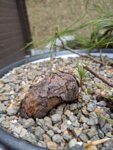sikadelic
Chumono
Hey folks. I went looking for dry land fish with some friends the other day and came across this tree on a rock face. I really loved the character of the bark and the gnarly natural twist it had at the base. The roots were amazingly flat as it had grown in what looked like decaying leaves. There were no downward growing roots and I literally just picked it up. No tools, no sweat, nothing. There was only one larger root that was growing parallel to the rock. I clipped it once I got home, but it has what I think to be a very reasonable bit of fine roots so I think it will bounce back pretty well. I know EWP can be a pain in the ass, but I'll see what I can do with it over the next few years.
And apologies if the pics aren't the best. I didn't plan for this and I just threw together what I could. Check back in a year or two. ?
And apologies if the pics aren't the best. I didn't plan for this and I just threw together what I could. Check back in a year or two. ?





